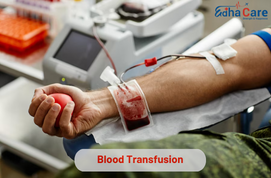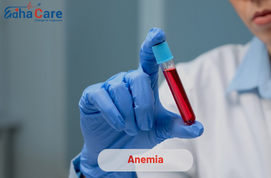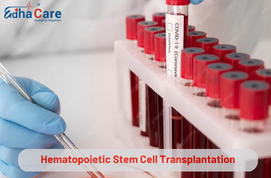Blood Transfusions

Blood transfusions involve the intravenous transfer of blood or blood components from a donor to a recipient, addressing conditions such as anemia, surgery, or trauma. Red blood cell transfusions augment oxygen delivery, platelet transfusions assist in clotting, and plasma transfusions provide clotting factors. Common in treating various hematologic disorders, transfusions aim to restore or maintain adequate blood volume and composition. Rigorous testing ensures compatibility and safety. While crucial in emergencies or medical interventions, careful consideration is given to prevent complications and tailor transfusion protocols to individual patient needs.
Book an AppointmentAbout Blood Transfusion
Blood transfusions become necessary in various medical scenarios to address specific conditions or emergencies. Here are common causes that may require blood transfusion:
-
Anemia: When the body lacks a sufficient number of red blood cells or hemoglobin, leading to reduced oxygen-carrying capacity, blood transfusions are administered to replenish the red blood cell count and improve oxygen delivery to tissues.
-
Surgery and Trauma: Major surgical procedures, particularly those involving significant blood loss, may necessitate blood transfusions to restore lost volume and maintain vital organ perfusion. Trauma, such as accidents or injuries, can also lead to substantial blood loss requiring immediate transfusions.
-
Cancer Treatments: Some cancer treatments, such as chemotherapy or radiation therapy, can suppress the production of blood cells. Blood transfusions may be necessary to counteract the resulting anemia or thrombocytopenia.
-
Hematologic Disorders: Certain medical conditions, including inherited or acquired disorders affecting blood cell production or function, may require regular blood transfusions. Examples include sickle cell disease or thalassemia.
-
Bleeding Disorders: Conditions that interfere with normal blood clotting, such as hemophilia or disseminated intravascular coagulation (DIC), may necessitate transfusions of clotting factors or platelets to control or prevent bleeding.
-
Medical Emergencies: In critical situations such as severe infections, sepsis, or organ failure, where there is a risk of shock or insufficient oxygen delivery to tissues, blood transfusions may be part of the emergency medical management to stabilize the patient.
Procedure of Blood Transfusion
Blood transfusion is a medical procedure involving the infusion of blood or blood components to address various conditions. Here's an overview of the treatment procedure in six key points:
-
Patient Assessment: Before administering a blood transfusion, healthcare providers conduct a thorough assessment of the patient's medical history, current health status, and specific indications for the transfusion. This helps ensure the procedure is appropriate and safe for the individual.
-
Blood Typing and Crossmatching: To prevent adverse reactions, the donor blood must be compatible with the recipient's blood type. Blood typing determines the ABO and Rh blood group, and crossmatching involves testing for compatibility to identify any potential reactions.
-
Informed Consent: Before the transfusion, healthcare providers explain the procedure, potential risks, and benefits to the patient. Informed consent is obtained, allowing the patient to make an informed decision about the treatment.
-
Blood Collection and Processing: Donor blood is collected from volunteer donors or blood banks, then processed to separate it into its various components—red blood cells, plasma, platelets, or cryoprecipitate—based on the patient's specific needs.
-
Administration of Blood: The selected blood component is administered intravenously to the patient. Vital signs are closely monitored during the transfusion to detect any adverse reactions promptly.
-
Post-Transfusion Monitoring: After the transfusion, healthcare providers continue monitoring the patient for potential reactions, such as fever, chills, or allergic responses. Prompt intervention can mitigate complications if they arise.
Require Assistance?
Get A Quick Callback From Our Healthcare Experts
Other Specilities We Cover

Anemia

Hematopoietic Stem Cell Transplantation (HSCT)




